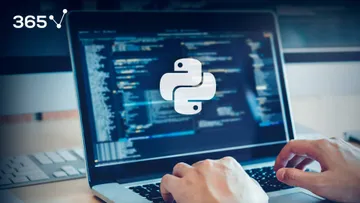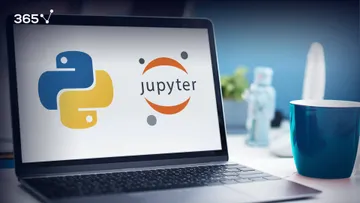If you are new to data science and have no prior programming background, it is a good idea to start with Python as your first language. Not only is its easy-to-read syntax ideal for beginners, but the vast array of libraries that it boasts effortlessly support the end-to-end workflow.
Learning Python is also a great way to future-proof your profession. According to Analytics Insight, it is one of the most widely used programming languages by data scientists, with many job possibilities as Python skills are highly in demand. Becoming fluent will make it easy for you to kickstart your own data science career, as well as transition into other fields like web development, software engineering, and data analytics in the future.
In this article, we will provide you with an easy-to-follow three-step approach on the best way to learn Python for data science as a beginner:
- Studying through online courses and tutorials
- Applying your knowledge through participating in coding challenges
- Taking on projects that will enrich your data science portfolio
How to Learn Python Step 1: Online Courses and Tutorials
If you have no programming background, a Python online course will provide you with the foundation you need to get started, including the general programming concepts that form the backbone of every programming language:
- Variables and data structures
- Basic operators
- Conditional statements
- Iteration
- Methods and functions
A strong grasp of these fundamentals will allow you to quickly learn and switch to different languages in the future. If you’re looking for a place to start learning, our Introduction to Python course offers a structured, straightforward approach. The first 3 modules are free, so you can try them to see if this course is a good fit.
So, why learn Python for data science? As a data professional, you will need to collect, process, clean, and analyze massive datasets. Thankfully, the programming language has many in-built modules that will allow you to do this easily. To illustrate, we have curated a comprehensive learning path to guide you on your way.
Data Collection
When working as a data scientist, a considerable portion of your work will involve collecting data from external resources. You will need to work with APIs and scrape data from the web using Python libraries.
Not sure where to start? Our Web Scraping and API Fundamentals in Python course will teach you the process of collecting external data.
Data Preprocessing and Analysis
In 2018, Harvard Business Review reported that data scientists spent around 80% of their time on data cleaning and preparation. This is because real-world datasets are messy. You will often need to deal with missing values, data inconsistencies, and type mismatches.
After cleaning and storing the data in a format that is easy to work with, however, you can perform further analysis. This involves querying large amounts of data to identify trends that provide valuable business insights for your organization. And of course, Python has libraries that allow you to find patterns and identify relationships between thousands of data points in just a few minutes.
Pandas is the most commonly used Python module for data analysis. It allows you to quickly group data, perform calculations on different variables, transform data, and deal with missing values.
If you’re looking for a beginner-friendly online learning resource for this specific Python library, then our Data Cleaning and Preprocessing with pandas course will offer you all you need to know.
Data Visualization
When analyzing large amounts of data, you will often need to create data visualizations to recognize trends and statistical relationships between variables. Many Python libraries can help you do this easily, such as Matplotlib, Seaborn, and Plotly.
For the ultimate resource, our team has developed The Complete Data Visualization Course with Python, R, Tableau, and Excel which will guide you as you perfect your visualization skills in Python – and more!
Machine Learning
Finally, you can start learning Python for machine learning. The programming language has many modules that allow you to build and train models in minutes. One of the most popular Python libraries for machine learning is Scikit-Learn, which has hundreds of algorithms you can choose from.
There is also high industry demand for data professionals with experience in Python’s deep learning frameworks like Keras and TensorFlow, so it is also helpful to have some knowledge of these libraries.
If you’re interested to learn more, our Machine Learning in Python course will walk you through the process of building your ML models.
How to Learn Python Step 2: Practice Coding Challenges
Taking online courses will equip you with the necessary programming foundation to become a data scientist, however, your Python learning journey doesn’t stop here.
To internalize the concepts, you need to practice and apply the knowledge you’ve gained in order to solve real-world problems. So, what’s the best way to enhance your Python problem-solving skills? Well, you can start by working on coding challenges.
Many sites out there provide users with a range of coding practice problems with varying levels of difficulty, such as Hackerrank, Coderbyte, and Codewars. You can start with the simplest programming questions and move on to more complex ones as you gain experience.
In addition, some of these sites have forums where users post their solutions. If you are stuck on a problem, a great way to learn is to look at how other coders have approached the situation. This will help you understand that there are many ways to solve the same problem, which will in turn improve your programming skills over time.
How to Learn Python Step 3: Projects
Once you can solve a variety of programming challenges, you can move on to creating your own Python projects from scratch.
Personal projects are not only a great way to learn to code, but they are also a nice addition to your portfolio. For a beginner with no prior work experience, this is the best way to demonstrate your data science skills to potential employers. In fact, many data scientist aspirants have managed to land data science interviews without any formal education or background in the field simply by presenting their work.
To make it easier, here are some data science project ideas that can be implemented in Python.
Data Collection: Create Your Own Database
As mentioned above, data collection is a necessary skill to have as a data scientist. Companies often rely on their data teams to source external data.
Using your newly honed Python skills, you can use APIs or web scrapers to collect data from the Internet. Then, consolidate all this data into a file or database format, and remove any inconsistencies you find. You can even post it on sites like Kaggle for other data scientists to analyze.
Data Analysis & Visualization: The Titanic Dataset
The Titanic Dataset is a great way to work on your data analysis and visualization skills. Inside you’ll find over 2,000 data points that represent passengers on the tragic ocean liner. Some variables include a person’s gender, family members, cabin, ticket fare, and whether they survived the crash.
You can perform some statistical analysis on this dataset with the help of Python libraries, such as pandas or Seaborn, in order to identify trends between the variables, then build visualizations to support your findings.
Here are some questions you can try to answer:
- Were male passengers more likely to survive the crash than female passengers?
- Did passengers who paid a higher ticket fare have a higher survival rate?
- Were younger passengers more likely to survive than older passengers?
Based on your findings, you can develop a report of the likeliest passengers to survive the sinking of the Titanic, which will add great value add to your portfolio.
Machine Learning : Iris Dataset
Finally, you can create a machine learning project in Python using libraries like Scikit-Learn. The Iris Species dataset is a great place to start. It contains information about 3 different iris flowers, with variables such as their petal width and sepal length. As an example, you can develop a machine learning algorithm that predicts each of the 3 species.
How to Learn Python: Next Steps
When you learn Python for data science, you essentially gain an understanding of the essentials of programming. By applying this knowledge into practice, you fill gaps in your knowledge, enhance your resume, and increase your chances of landing an entry-level data science role. That is just the first step on the ladder – and we’re here to help you make it.
Our 365 Data Science Program offers self-paced courses led by renowned industry experts. Starting from the very basics all the way to advanced specialization, you will learn by doing with a myriad of practical exercises and real-world business cases. If you want to see how the training works, start with a selection of free lessons by signing up below.







